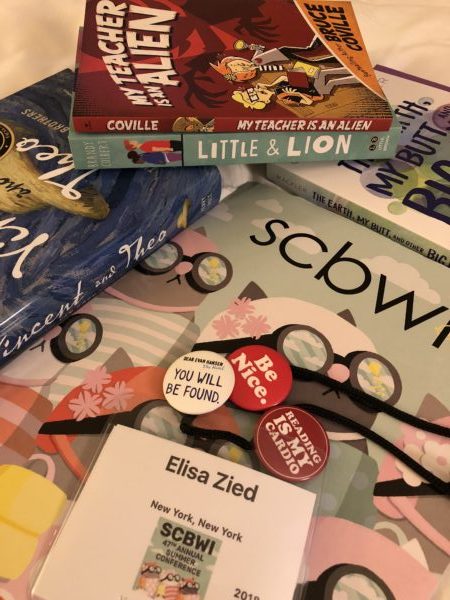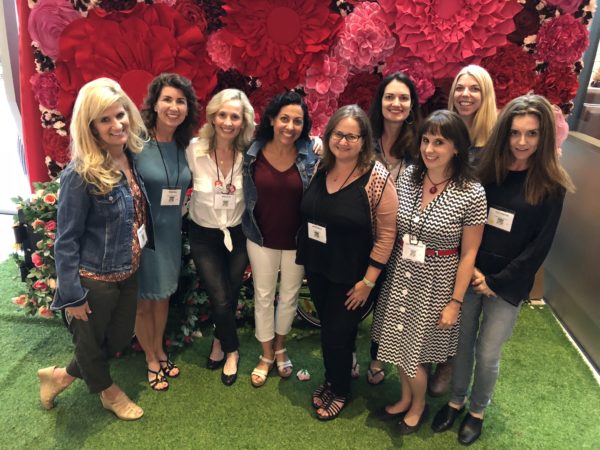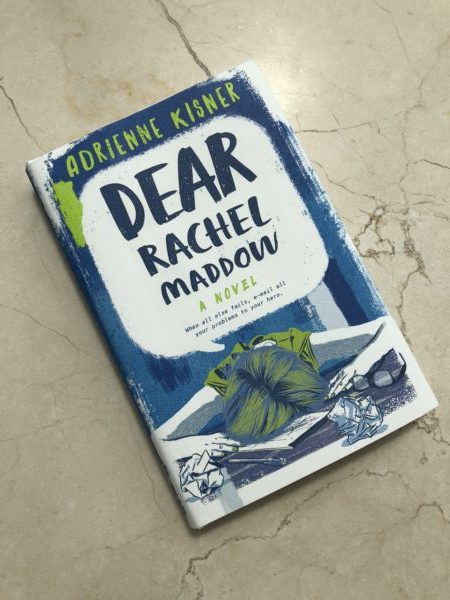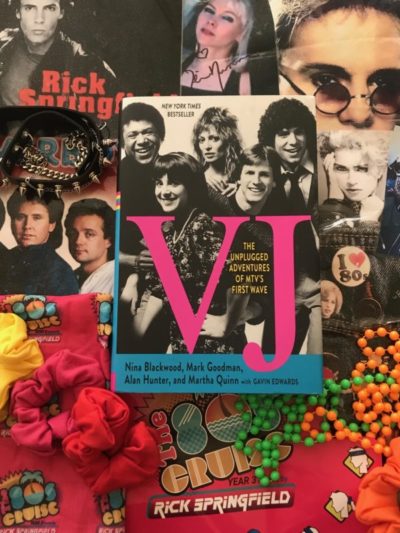by Elisa Zied | Aug 6, 2018 | books, writing
 This weekend, I geeked out at the Society for Children’s Book Writers and Illustrators Summer Conference in Los Angeles, California. With homework and deadlines approaching, I was nervous about attending, wondering whether I could really afford to lose valuable study time. And of course I felt some Jewish mom guilt to leave my family less than a week after my 16-year-old returned from a summer program. Fortunately, I got a lot of reading and writing done on my 6-hour flight (with an additional hour on the runway). And while three full days of panels, workshops and keynotes with an amazing faculty of authors, agents and editors kept us busy, it was unbelievably inspiring and well worth every minute.
This weekend, I geeked out at the Society for Children’s Book Writers and Illustrators Summer Conference in Los Angeles, California. With homework and deadlines approaching, I was nervous about attending, wondering whether I could really afford to lose valuable study time. And of course I felt some Jewish mom guilt to leave my family less than a week after my 16-year-old returned from a summer program. Fortunately, I got a lot of reading and writing done on my 6-hour flight (with an additional hour on the runway). And while three full days of panels, workshops and keynotes with an amazing faculty of authors, agents and editors kept us busy, it was unbelievably inspiring and well worth every minute.
Besides making new friends, I spent quality time with a wonderful group of supportive and loving writer friends (several pictured below). I was also excited to see recent VCFA graduates and fellow students I had gotten to know—at least a little bit—during my recent grad school residency. Two even won awards—an Emerging Voices award for my fellow firstie at VCFA, Lakita Wilson, and a graduate award for recent VCFA grad Jessica Lee!) So, in many ways, coming to LA for this incredible conference felt like coming home.

As always, I took full advantage of the conference, attending all but one keynote. The speakers were wonderful, especially Andrea Davis Pinkney and Brian Pinkney who put on a spirited and enjoyable show (such talent they both have), Libba Bray (a real writer’s writer), Lynda Mullaly Hunt and Bruce Coville (way to make me cry while touching and inspiring me), and Lois Lowry, the 81-years-young author of The Giver (pictured below while signing my book). I can’t wait to read her book about human connection set to launch in 2020.

There were so many highlights of the conference—too many to name. But I thought I’d share my top 10 takeaways list (in no particular order). I’m already thinking of when and how to incorporate many of these ideas into my writing/life, and invite my writer friends to do so as well.
10. Daniel Jose Older, author of Shadowshaper: The sound and rhythm of words matter. Read work aloud so you can hear it.
9. Elana K. Arnold, author of What Girls Are Made Of:
- Tension is the spinal cord of books. Increase tension by asking What if questions, play with time, add a ticking clock, and/or write your character into a corner that you don’t know how to get her out of.
- Think of ten scenes that are integral to your novel and write them. Write one sentence at a time.
8. Lynda Mullaly Hunt, author of Fish in a Tree:
- You pass by ideas every single day. When you feel emotion, jot it down (or talk into your phone about it).
- Write what you’re ashamed of…what you don’t want anyone to know, what you haven’t yet figured out.
7. Andrea Davis Pinkney, author of The Red Pencil: Meet hate with love. Every morning, spend some time thinking of things that make you happy. Then write.
6. Amanda Maciel, author of Tease: Who does your protagonist think she is, and what do other people think she is? What are the expectations placed on her? And who is she beyond those expectations? What’s important to her? Assess everything from her eyes.
5. Libba Bray, author of The Diviners: What is the purpose of your story, the spark that lights the fuse? What answer do you seek? The question is about growth…bringing us somewhere. Push aside vanity and the desire to be liked and write from a deep, vulnerable place. Do not think about how the story will be received.
4. Erin Entrada Kelly, author of Hello, Universe:
- We were never kids’ age in the age of technology. Don’t think about kids through the lens of your teen years. Use the emotions you felt in your childhood years, but learn and understand what their world looks like today.
- When revising, ask, “Why is this here? What is this scene/chapter/sentence doing here?
3. Eliza Wheeler, author/illustrator of Miss Maple’s Seeds:
- We confuse our identities with our work. The work is not us.
- The real goal in creating art is to love the process so much that you want to show up to do the work.
2. Bruce Coville, author of My Teacher is An Alien:
- Why do you want to write? Keep asking the whys. Then you’ll understand and it’ll inform your work.
- Small actions ripple the world and small gestures can be a turning point.
- Do not start writing books with a message. Start with your own good heart.
1. Here are just a few of the books I’m adding to my TBR list as a result of attending this conference:
- My Teacher is an Alien by Bruce Coville
- The Earth, My Butt, and Other Big Round Things by Carolyn Mackler
- Little and Lion by Brandy Colbert
- Vincent and Theo: The Van Gogh Brothers by Deborah Heiligman
- Out of Wonder: Poems Celebrating Poets by Kwame Alexander with Chris Colderley and Marjory Wentworth, illustrated by Ekua Holmes
If you attended the SCBWI Summer Conference, what were your takeaways?
To learn more about the conference—and about SCBWI, an organization I’m SO proud to be part of—visit the website here.
by Elisa Zied | Jul 26, 2018 | books, fiction
 When I learned a friend of friend wrote a book called Dear Rachel Maddow, I was overjoyed. A big fan of The Rachel Maddow Show which airs weeknights on MSNBC at 9:00 P.M., I often joke the show is the glue to my marriage.*
When I learned a friend of friend wrote a book called Dear Rachel Maddow, I was overjoyed. A big fan of The Rachel Maddow Show which airs weeknights on MSNBC at 9:00 P.M., I often joke the show is the glue to my marriage.*
Here’s a description of Adrienne Kisner’s debut young adult book, Dear Rachel Maddow, from Amazon:
Brynn Haper’s life has one steadying force–Rachel Maddow. She watches her daily, and after writing to Rachel for a school project–and actually getting a response–Brynn starts drafting e-mails to Rachel but never sending them. Brynn tells Rachel about breaking up with her first serious girlfriend, about her brother Nick’s death, about her passive mother and even worse stepfather, about how she’s stuck in remedial courses at school and is considering dropping out.
Then Brynn is confronted with a moral dilemma. One student representative will be allowed to have a voice among the administration in the selection of a new school superintendent. Brynn’s arch nemesis, Adam, and ex-girlfriend, Sarah, believe only Honors students are worthy of the selection committee seat. Brynn feels all students deserve a voice. When she runs for the position, the knives are out. So, she begins to ask herself: What Would Rachel Maddow Do?
Although I had never read an epistolary novel before, I so enjoyed Kisner’s book. I found the format to be an effective way to tell Brynn’s story. Her struggles in school–and in the context of her family–were compelling, and the humor sprinkled throughout the novel was a nice touch that drew me in. Despite the book’s title, Kisner does not beat readers over the head with politics; instead, she seamlessly weaves in subtle descriptions of Maddow’s personality and show to support Brynn’s admiration for her.
Kisner was kind enough to do an email Q & A about the book and her writing life. Here are the highlights.
Zied: I read on your blog that you were inspired to write Dear Rachel Maddow after having your first child aka Screamy Baby. Can you elaborate?
Kisner: I live on a college campus. Our cable television was great for late-night-don’t-sleep types until one sad day right after my daughter was born. They took away the WE network and I didn’t really know what to do with myself. I aimlessly flipped until I settled on our new assortment of myriad news channels. Rachel Maddow repeated at least twice a night . . . possibly more, my memory from those days is dream-like. Then I discovered her podcast where I could listen to her while doing chores. Things are always new when your short term memory is shot from sleep deprivation. So it’s like it didn’t even repeat.
Zied: What is it about Rachel Maddow that led you to make her someone your protagonist reveres/reaches out to (if mainly in spirit)?
Kisner: Rachel is so smart and civil and engaged in this world. All the things my main character does not think herself to be, but to which she really aspires deep down. Rachel’s often really funny on her show, too. How can you not like that? (I mean, I know it’s possible. I’ve seen Twitter. But still.)
Zied: To write the book, did you plot or pant, or do some combination of both?
Kisner: I’m a pantser, all the way. Plotting baffles me.
Zied: Did you have a specific schedule/routine while writing this book?
Kisner: None. I have to squeeze in writing whenever I can, around work and family and stuff. I’d have an hour one day, fifteen minutes the next, none for two weeks.
Zied: When and how did you decide to use the epistolary format to write this book?
Kisner: Initially I’d planned to really rip off the Dear Mr. Henshaw format—write half of it in letters, then go to more of a journal. And it sort of goes like that. But Brynn, the main character, wouldn’t really write in a journal. I think she wanted to connect with someone, outside herself. She’d only write (or dictate) if it were to someone else.
Zied: You hold both a master’s and doctorate degree in theology. How do you think your studies have informed or influenced your book (if at all)?
Kisner: I don’t know. The longer I went on studying faith, the more I became convinced that people who claim to know God’s will, probably don’t. Mystery and faith seeking understanding and dialogue are stressed in the circles I run in. Here, notions of what “sin” is become more situated in the unknowable mind of God, so I got more and more pissed off that the government should try to legislate off the unknowable mind of God. If anything, the excessive amount of time I spent studying theology gave me a true appreciation for the importance of the Establishment Clause and the Free Exercise Clause in the First Amendment. That people are screwing with that in the name of the ineffable is infuriating and dangerous.
Zied: What made you want to write novels for teens?
Kisner: Teens are awesome. I don’t understand why everyone doesn’t write for teens. I assume people who write for adults do so because writing for kids is too hard.
Zied: How did your MFA studies at Vermont College of Fine Arts** help prepare you both creatively and professionally to become a young adult novelist?
Kisner: VCFA gave me a community of writers, many of whom are now my best friends. I’ve had other people simply stop talking to me because I was too much or not enough or something tied to my life as a creator of things. That sucked. The inevitable ups and downs of the industry make for a wild ride, too. VCFA gave me lectures to polish my craft, but also gave me mentors and friends who are always in my corner. I love them all.
Zied: Have you shared your book with Rachel Maddow (if she’s anything like I’d suspect, she’d be flattered not to mention gracious).
Kisner: Welllll . . . I think she got an ARC? Lol. Not from me, per se. Because she is a real person whose name is on this thing that I wrote. I honestly wrote it thinking it would be another novel that no one would ever see (like so many of my novels before it). So when it was the one that sold, I thought she should be allowed the space to ignore it entirely. I have no doubt she’s lovely. But I don’t try to push it. I don’t want her to feel like she ought to be gracious. Fame has to be wearing enough without one more thing. (Though I have friends who @ her on Twitter. I do think that’s kind of funny, I admit.)
Zied: What’s next for you?
Kisner: A book about girl birders. I think of it as “Dear Rachel Maddow” meets “The Big Year.” I have dream goals of inspiring a few readers to both vote and go birding.
*My like-minded husband and I love Rachel’s ability to tell stories and give context to the ever-changing state of the union. Especially now!
**I began my MFA studies at VCFA in July. Read about my writing journey here.
To learn more about Dear Rachel Maddow and Kisner’s work, visit her website here.
by Elisa Zied | Jul 20, 2018 | young adult books

Last week, I started grad school at Vermont College of Fine Arts to pursue an MFA in writing for children and young adults. I first learned about the low-residency program a few years ago after reading the book jacket of Jandy Nelson’s incredible young adult novel, I’ll Give You the Sun. Since I devoured her book — in fact, I love it so much I’m rereading it now — I went on the VCFA website to learn about the program. I subsequently attended VCFA’s annual Writing Novels for Young People retreat three times and simply loved the experience and the wonderful community fostered there.
Although I had a million and one reasons to avoid going back to school — how could I leave my home and family for 10+ days twice a year, and how would I fit in the 25+ hours of study (which for me will be many more since I’m not a fast reader or writer)? And what about my 22-year nutrition career? Even if I were to be accepted, would I be worthy to study among so many talented students? Would I have earned the right to learn from such an esteemed faculty?
Fast forward to now. Fears and all, I applied, was accepted, and am now a proud VCFA grad student. And I could not be more excited. (more…)
by Elisa Zied | Jun 25, 2018 | Uncategorized
 When MTV made its debut on cable television on August 1st, 1981, I was spending my third summer at Kutsher’s Camp Anawana in the Catskills. A few weeks shy of my 12th birthday and my first kiss, despite having a mouthful of metal (if you must know, the lucky boy was Todd Goldman, who also wore braces), my introduction to the VJs and the trove of music videos that would make the music and artists I already loved – or hadn’t yet discovered – come to life, would have to wait.
When MTV made its debut on cable television on August 1st, 1981, I was spending my third summer at Kutsher’s Camp Anawana in the Catskills. A few weeks shy of my 12th birthday and my first kiss, despite having a mouthful of metal (if you must know, the lucky boy was Todd Goldman, who also wore braces), my introduction to the VJs and the trove of music videos that would make the music and artists I already loved – or hadn’t yet discovered – come to life, would have to wait.
When I returned home, it didn’t take long for me to “want my MTV” – and, like everyone else fortunate enough to have cable, to get hooked on it. The VJs, Mark Goodman, Alan Hunter, Nina Blackwood, Martha Quinn, and JJ Jackson were the coolest of the cool. They became my older, virtual siblings, guiding me on a unique and multisensory journey that in many ways shaped and define my adolescence. The music videos they delivered to our living room television – and into my heart – were fuel for my hormones, inspiring everything from my wardrobe (I wore lace, rubber bracelets, one earring and a fake mole like Madonna) and my workouts (let’s just say I got physical with Olivia Newton John) to my locker and bedroom décor (pictures and posters of Madonna, Michael Jackson, Prince, and Billy Idol) to my lip sync selections (I “performed” Madonna’s “Dress You Up” and Belinda Carlisle’s “Mad About You” at my high school’s Superdance fundraisers).
(more…)
 This weekend, I geeked out at the Society for Children’s Book Writers and Illustrators Summer Conference in Los Angeles, California. With homework and deadlines approaching, I was nervous about attending, wondering whether I could really afford to lose valuable study time. And of course I felt some Jewish mom guilt to leave my family less than a week after my 16-year-old returned from a summer program. Fortunately, I got a lot of reading and writing done on my 6-hour flight (with an additional hour on the runway). And while three full days of panels, workshops and keynotes with an amazing faculty of authors, agents and editors kept us busy, it was unbelievably inspiring and well worth every minute.
This weekend, I geeked out at the Society for Children’s Book Writers and Illustrators Summer Conference in Los Angeles, California. With homework and deadlines approaching, I was nervous about attending, wondering whether I could really afford to lose valuable study time. And of course I felt some Jewish mom guilt to leave my family less than a week after my 16-year-old returned from a summer program. Fortunately, I got a lot of reading and writing done on my 6-hour flight (with an additional hour on the runway). And while three full days of panels, workshops and keynotes with an amazing faculty of authors, agents and editors kept us busy, it was unbelievably inspiring and well worth every minute.

 When I learned a friend of friend wrote a book called
When I learned a friend of friend wrote a book called 
 When MTV made its debut on cable television on August 1st, 1981, I was spending my third summer at Kutsher’s Camp Anawana in the Catskills. A few weeks shy of my 12th birthday and my first kiss, despite having a mouthful of metal (if you must know, the lucky boy was Todd Goldman, who also wore braces), my introduction to the VJs and the trove of music videos that would make the music and artists I already loved – or hadn’t yet discovered – come to life, would have to wait.
When MTV made its debut on cable television on August 1st, 1981, I was spending my third summer at Kutsher’s Camp Anawana in the Catskills. A few weeks shy of my 12th birthday and my first kiss, despite having a mouthful of metal (if you must know, the lucky boy was Todd Goldman, who also wore braces), my introduction to the VJs and the trove of music videos that would make the music and artists I already loved – or hadn’t yet discovered – come to life, would have to wait.
Recent Comments